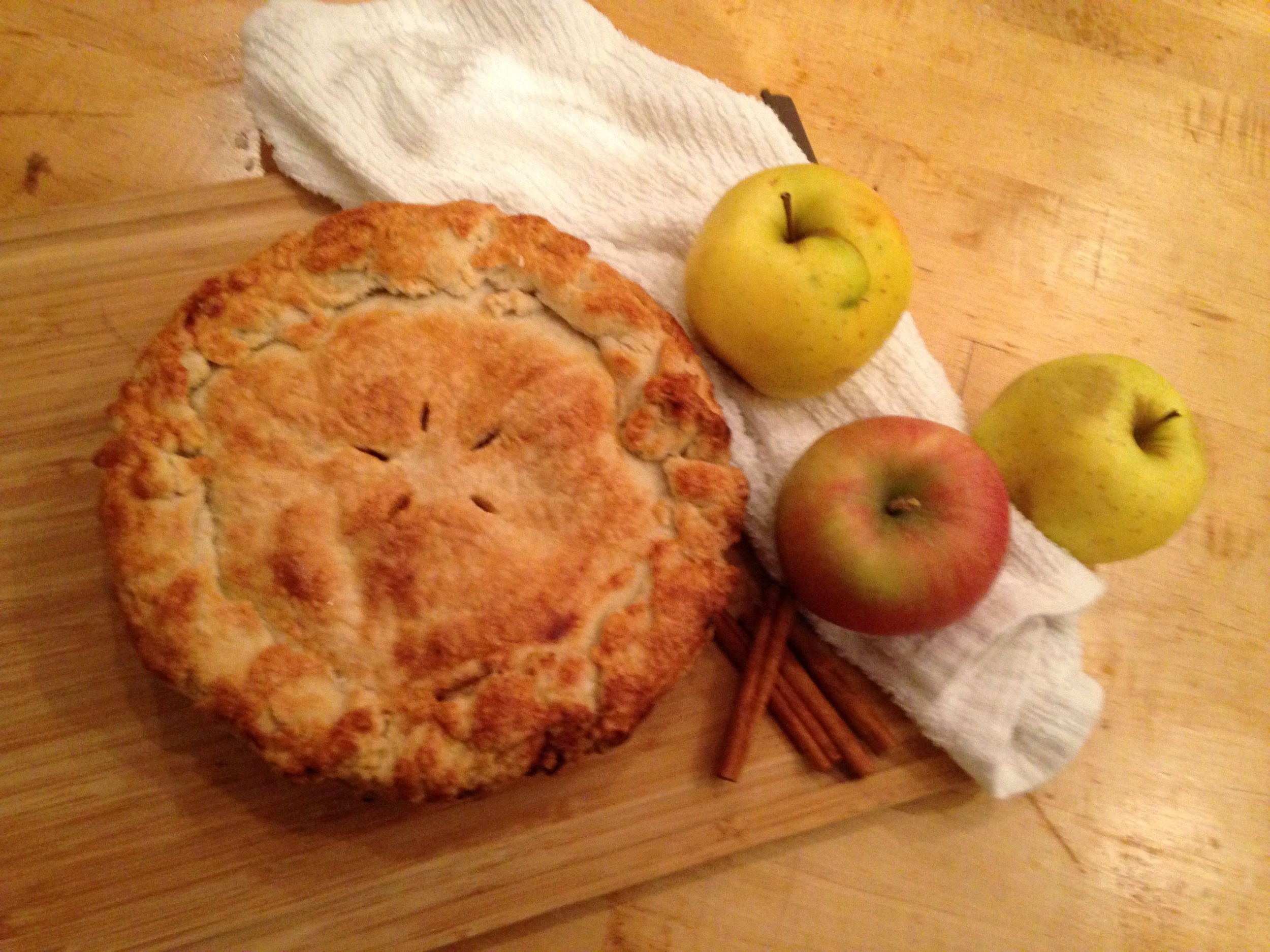
Nearly every great chef will say that cooking is an artform. But many fail to mention the craft also relies on some pretty well-established hard science. Few know this better than Jeff Potter, author of Cooking for Geeks, a book for those looking to improve their culinary skills through a richer understanding of exactly how stuff works in the kitchen.
This is why Potter, a self-proclaimed food and science geek, will be the first to report that a pie isn't just a pie. The dessert you're about to eat is chock-full of lessons in chemistry, physics and neurobiology. And whether or not your holiday guests ask for second slice depends on how well you master the basics of science.
"If you are somebody who wants to not always follow a traditional recipe, you want to experiment with how to make the pie better or you want to to avoid a certain failure, understand that science is the key," says Potter. "When something isn't working right, you have a way to look at it and go: Why is this failing, and how can I correct this?"

The golden brown color of the pie crust is a fine display of Maillard reaction, also sometimes called the "browning reaction."
"It's the protein and a simple sugar that combine under heat, and then they break down and form a hundred different compounds. The sugar itself—in this case sucrose—is a specific molecule that when you heat up undergoes decomposition," says Potter. As the reaction between the sugars and amino acids occurs—at around 310 degrees Fahrenheit—these compounds rearrange themselves by glomming onto water molecules. But this chemical reaction isn't just picture perfect. It's also partially responsible for the pie's amazing smell. As the molecules continue to form, they produce the familiar aromas of baking. Incidentally, this phenomenon is named after French chemist Louis Camille Maillard, who was the first to identify this interplay between sugars and amino acids in a paper he published in the early 1900s.
Pie crust is also about texture; a good one is flaky and buttery, not soggy or chewy. It falls apart easily when you take a bite. Potter calls this pastry dough sweet spot fracturability. In order to accomplish this baking feat, you need to control the formation of gluten when preparing the dough. Gluten provides a stretchy elasticity to food (think about the inside of the best baguette you ever ate). It's created when two proteins in flour —glutenin and gliadin—become damp. "They crosslink and form a long mesh and turn into stretchy elastic stuff," says Potter. "Gluten requires water." So the secret to good pie crust is to limit the formation of gluten by not using a lot of water.
Now what about the gloppy gooeyness of the filling? The pie's innards rely on getting the right viscosity, or thickness. You can use a thickener such as cornstarch to achieve a sticky and slightly wet consistency; you want it almost gel-like. "It's actually a 3-D mesh where the different molecules are binding to each other," Potter says. Fruit that is ripe is a great pie filling because it contains naturally occurring pectin. According to Potter, a ripe apple is 10 to 20 percent pectin, a "cellular glue that holds cell walls together, similar to how collagen holds muscle tissue." The pectin compounds begin to break down when heated above 140 F. Pectin is also used as a setting agent for jams and preserves.
The only thing better than a slice of warm pie is one accompanied by ice cream. "Ice cream is actually really complicated," says Potter. "You could teach an entire lesson on ice cream." One thing to know about the sweet creamy stuff, says Potter, is the role of colloidal dispersion, when a compound of certain substances, in this case individual ingredients, are evenly distributed as fine particles. "Colloids are a combination of different types of matter," says Potter. "Foods are almost never one state of matter. There's usually something in them that causes them to be multiple states of matter—solid, liquid and gas." To the naked eye and your mouth, that ice cream may seem like a perfectly blended mixture, but it's not. "Ice cream is a complex colloid—multiples types of colloids at once—being water-based liquid containing pockets of air (foam), chunks of ice crystals (suspensions) and fats (emulsions) all at the same time," Potter wrote in his book.
But what about the science of the first bite? Why exactly is pie so pleasing to eat? You can thank your brain's ability to process the scent, taste and sight of the food on your dish all at once—a process known as sensory integration.
Your sense of taste starts in the receptor cells in each taste bud on the tongue and elsewhere in the mouth, such as the hard palate. "Each of these cells can interact with various types of chemicals, which are carried to them by our saliva as we chew food," Potter wrote in his book. "Once activated, the receptor cells transmit the signals to our brains, which assemble all the signals into a relative strength for the taste."
But, according to Potter, your sense of taste only accounts for about 20 percent of the experience of food's flavor. Try taking a bite of something while pinching your nostrils shut; it's almost guaranteed that you won't enjoy that pie quite as much. In the case of apple pie, "you would just taste the sourness or the sweet, but you wouldn't experience the smell of the cinnamon," says Potter.
Your eyes also play a role. "You look at it and you know what it is because you identify it with your past history," says Potter. "If you've never had apple pie before, you'll think, What is this thing?" It's a fine example of the magic of visual memory and perhaps a softer science known as psychology.
Once you understand how science plays on the palate, you can work all sorts of magic. Take one of Potter's favorites: A mock apple pie doesn't contain any apples. Instead, it uses crackers—and a keen sense of science—to manipulate the mind of anyone who reaches for a slice.

Mock Apple Pie
Potter says the oldest known reference to mock apple pie is from around the 1850s. But back in the day, cooks used a more basic cracker rather than buttery Ritz.
"Essentially, before you had the availability of apples year-round, and you wanted to make apple pie, what would you do?" explains Potter. "From a modern point of view, it's really fascinating. You get this thing that you think is an apple pie; it looks like an apple pie."
But it isn't.
The recipe works and tastes authentic primarily because of a certain special ingredient called cream of tartar, which is potassium bitartrate. It's the sediment left over in the barrel after wine is fermented. After the stuff is purified, it becomes a white powder that makes an appearance in many baked goods. It adds a punch of acidity and sourness that apples or other fruit typically provide but that's missing when you swap out the natural fruit filling for a bunch of Ritz crackers. In apples, the tart taste comes from the fruit's malic acid, a compound that is produced by all living organisms.
"Cream of tartar doesn't smell like apple—none of the odorants are present—but the taste of sourness is spot on," says Potter.
This mock apple pie fooled Newsweek's newsroom. See if your family and friends also fall for the trick this holiday season.
Recipe from Cooking for Geeks, Second Edition by Jeff Potter
Ingredients:
Homemade or store-bought pie crust
1½ cups water
2 cups sugar
2 teaspoons cream of tartar
30 buttery crackers (Ritz brand is the most commonly used)
1 teaspoon cinnamon
1 teaspoon vanilla
¼ teaspoon nutmeg
2½ tablespoons lemon juice
Zest from 1 lemon
2 tablespoons butter
Instructions:
Preheat oven to 425 degrees Fahrenheit. Line your pie pan with pie dough. In a saucepan, add the water, sugar and cream of tartar, cooking until it boils. Reduce the heat to medium and let the syrup simmer until it's slightly thick, to around 235 to 240 degrees Fahrenheit. Remove from heat and allow the pan to cool for a few minutes.
Next, add the crackers, cinnamon, vanilla, nutmeg, lemon juice and lemon zest to the pan. Stir gently, being careful not to overmix, since the crackers should remain in large pieces. Pour the mixture in the pie dish. Cut up the butter in small pieces and place on top of the pie filling. Sprinkle in a little extra cinnamon.
Place the top crust on the pie and pinch together the edges of both crusts around the entire pie. Using a small knife or fork, make several small slits at the top so steam can vent while the pie cooks (and to give your dish a classic, authentic look).
Put the pie in the oven and bake for approximately 30 minutes until the crust is golden brown. The pie is tastiest (and most convincingly like the real thing) when warm and served à la mode, with a scoop of vanilla ice cream.
Uncommon Knowledge
Newsweek is committed to challenging conventional wisdom and finding connections in the search for common ground.
Newsweek is committed to challenging conventional wisdom and finding connections in the search for common ground.
About the writer
Jessica Firger is a staff writer at Newsweek, where she covers all things health. She previously worked as a health editor ... Read more





